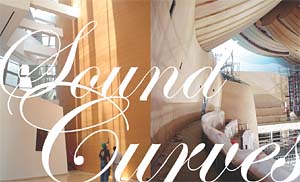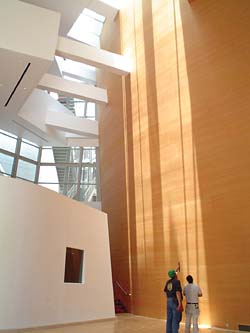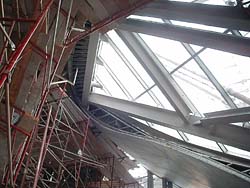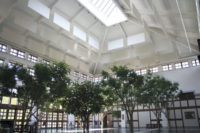
Walt Disney Concert Hall stands in downtown Los Angeles as a culmination of Architect Frank Gehry’s vision, combined with cutting-edge technology and contractors’ forward thinking. Anticipated to rival such architectural works as the Getty Center and acoustically configured to hold its own against the best concert halls in the world, this structure has set a new standard in the construction industry.
Initially designed in 1988, the Concert Hall plans have endured numerous changes from the design to the materials utilized in construction. The final result is a striking stainless steel exterior shaped like a series of larger-than-life sails, each curve itself unique.
The interior is equally as intricate, with hardwood walls, high ceilings and skylights, creating an open atmosphere of natural light. Each wall flows into the next, curving into unique touches, such as tree columns and a pipe organ that fans out like a forest. An enormous boat-like hardwood ceiling is suspended above the 2,273-seat auditorium, at the heart of the building.

Push the learning curve
A design of this magnitude demands the creation of new construction techniques. In keeping with architects' plans for complex surfaces, contractors had to create walls and ceilings that were acoustically sound, seismically correct and within budget restraints. Acoustical concerns were paramount to the project's success, as any slight deviation from architects' plans could significantly threaten the sound quality of the room.Martin Bros.-Macrowall Inc., the Gardena, Calif.-based contractor involved with the project for the past eight years, was charged with finding ways to make these plans a reality. Joe Riley, project manager and estimator for Martin Bros., is not a person opposed to taking risks. He saw opportunity in the limitless challenges of the project.
"This industry is for the type-A personality who likes to be overloaded," Riley explains.
Among the many challenges Martin Bros. confronted was choosing a method of building the wall surfaces to meet the given geometry exactly. The concert hall was designed as steel stud walls covered with drywall, veneer plaster or wood paneling. All the wall and ceiling surfaces in the hall have steel stud framing or are built out of steel framing, which creates and models the design geometry. The challenges presented to all the contractors was to find a way to make the design and construction intent happen with today's technology. Traditional methods such as stretchforming, ruling and molding proved to be too limiting to use exclusively.
Radius Track Corp., of Minneapolis, Minn., offered a breakthrough method that made it feasible to curve steel studs in any direction and in any length. Chuck Mears, president of Radius Track, has been fine-tuning his process since his first machine in 1996.
There are several possible methods for building complex surfaces in the drywall industry. Simplifying the surface curves from complicated curves into simple arcs that closely approximate the origianl curve or surface is one way.
"The designers and engineers of the Disney Concert Hall needed solutions to the wall and ceiling framing problems that did not require simplification of the surfaces," Mears says. "Each time you simplify something, you are changing it, even slightly, into something else."
Radius Track used a computer-controlled machine that is a scaled-up version of the company's "Track Bender" line of tools to bend steel studs into desired shapes. With numerical data extracted from computer programs, the machine grips the metal, moves it forward, bends the metal and pushes it through, resulting in precisely curved pieces. Instead of simply stretching the metal, compound indentations are created in studs and track runners at regular intervals by bending to shorten the distance along the flange and web. From computerized readouts, spacings and bend angles can be adjusted accordingly. As the studs are completed, each is labeled with a number identifying its future location and orientation in the building.
"One of the benefits of our curving method is that it doesn't require any forms and it doesn't require special tooling for each shape," he explains.
"Other methods bend steel to a compound radius shape," Riley agrees. "But those methods would not have been cost-effective in this project because they clamp the ends of the studs on preset jigs or molds made custom for each stud and require more length on the material for the process."
This process does not use any clamping methods or require extra material than what the stud length is.
The pieces Radius Track made for the concert hall met the requirements for accuracy within 1/8 of an inch, key to keeping with acoustical standards.
"Long, flexible pipes were used to make sure it was right and flowed well but the fact that our pieces were dead-on to start with made this all possible," Mears says. "Structural load-bearing tests also passed with flying colors."
Although some walls in the Concert Hall could have been made with straight elements, the complex design presented load-bearing problems. The solution was to slice the walls vertically, resulting in wires that represented the geometry and position of the steel stud framing required.
To create a sound wall, each outside wall that is covered in wood also has another wall about a foot behind it that's covered with plaster.
"When we were building this, there was an incredible developing of methodologies in the first place and getting the data from the architects through our production shop and then out to the field installation, all electronically, so everyone always knew where each of the thousands of pieces go," Mears says.

New use for aerospace technology
A computer program originally intended for aerospace design was the vital component in providing architects' data to the key construction players. Architects and contractors both worked off of models of the building on CATIA on CAD software, which displayed a 3-D model of the hall that could be rotated in 3D space.Riley saw the software as a way to keep all the main players on the same page and believes the SOF FTP site and master model of the structure make this job cutting edge.
He used the CAD software to get 3D wires and X, Y and Z points from CATIA. From the models, the team would look at the secondary steel and determine how much room they had left between the secondary steel and the face of the iron.
"We would have three properties we evaluate to hold the weight, looking at the stud component: stud size, gauge of the stud and the flange," Riley explains. "That was only in the background of coming up with a concept of how we were going to frame it."
"The only way was to use computer models," Mears agrees.
His team relies heavily on the CAD master model for their work as well. They export the points from CAD to RHINO, which gives them freedom to manipulate the points and images and provide renderings of shapes. The points are then exported to EXCEL, where mathematical data is processed to create the actual curved pieces. Transferring the data from CAD makes it possible for studs to fit the design exactly.
"Every new design challenge that arises gives us the opportunity to make something work a little better," says Mears.
The ability to build virtually any shape that can be put on a computer screen means less architectural restraints and more freedom in design. The Walt Disney Concert Hall is a benchmark work of architecture and construction, with a foundation of technology and innovation that future projects will build upon. The $274-million home to the Los Angeles Philharmonic is now complete, its doors opening for the first concert on October 23.


Report Abusive Comment